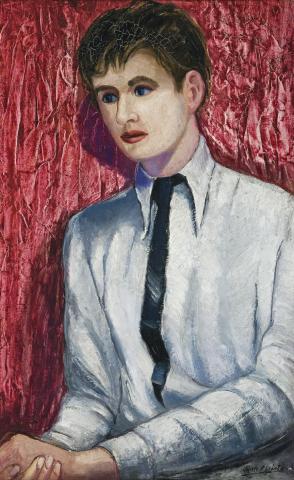PORTRAIT OF FRANCIS BACON, 1935
Roy de Maistre
oil on board
64.5 x 41.5 cm
signed lower right: R de Maistre
Gladys MacDermot, London
Thence by descent
Private collection, Switzerland
Sotheby's, Melbourne, 24 November 2008, lot 71
Private collection, Victoria
Roy de Maistre: A Retrospective Exhibition of Paintings and Drawings 1917–1960, Whitechapel Art Gallery, London, May – June 1960, cat. 40
Farson, D., The Gilded Gutter Life of Francis Bacon, Century, London, 1993, p. 28 (illus.)
Johnson, H., Roy de Maistre: The English Years 1930–1968 , Craftsman House, Sydney, 1995, p. 26
Roy de Maistre's friendship with Francis Bacon began in the late twenties or early thirties, de Maistre being a highly influential figure for the much younger artist. As Michael Peppiatt has written, 'De Maistre arrived in [Bacon's] life just when Francis urgently needed a father-figure and mentor; his influence on Bacon turned out to be both opportune and decisive.'1 With Europe in the grips of the Great Depression, De Maistre not only aided Bacon in gaining many of his early commissions, but also had 'a decisive influence in other areas of Bacon's life at this time...'2 Significantly, both artists shared a similar background, and it was through de Maistre's influence that Bacon moved from interior decorator to painter. Of de Maistre's first solo exhibitions in London in 1930, one was at the Beaux-Arts Gallery and the other at Bacon's studio.
The self-destruction of much of Bacon's early work limits our knowledge of his style at this time but there is tantalising evidence of a questionable self-portrait from around 1930. If genuine, it reveals the influence of de Maistre on his early painting - brasher than the genteel style of de Maistre, but lacking 'the vigour and audacity we associate with his later work.'3 De Maistre himself was a curious mixture. His civilised manner had been cultivated by his time in France; he was, as his friend, Tate Gallery Director Sir John Rothenstein described him, 'unequivocally European'. Yet he remained fixedly Australian, his fastidious Edwardian appearance at some variance to his analytical intellect and personality.4 Of his painting, Rothenstein wrote, 'It is an austere, serious art, with a touch of remoteness about it and nothing at all of bonhomie or fashionable clich.'5
The meeting of the youthful artist prodigy and the urbane painter was the exciting mix that produced such a fascinating portrait. Indeed, portraits may be considered two-way mirrors, revealing as much about their creator as about the sitter. Moreover, likeness is but the matter; to make it a work of art is another thing altogether. In Portrait of Francis Bacon, Roy de Maistre achieved both - appearance, insight, and his own sense of things. Others have commentated on this appearance of Bacon in his twenties, of striking red lips, all so distant from the disturbing physical distortion that became so much a feature of Bacon's own later portraits in his painted essays on tortured existence and the violence of human suffering. By sharp contrast, de Maistre's portrait of Bacon shows much affection and sensitivity. Peppiatt's words describe it well - 'a slim young man with a face all but devoured by the intensity of his gaze and the sensual fullness of his mouth: a study in youthful idealism and vulnerability.'6
1. Peppiatt, M., Francis Bacon: Anatomy of an Enigma, Weidenfield & Nicholson, London 1992, p. 48
2. ibid.
3. Peppiatt, op. cit, pp. 320-321
4. Rothenstein, J., 'Roy de Maistre', Art and Australia, Vol.4, No.4, March 1967, p. 296
5. ibid., p. 293
6. Peppiatt, op. cit., p. 74
DAVID THOMAS
